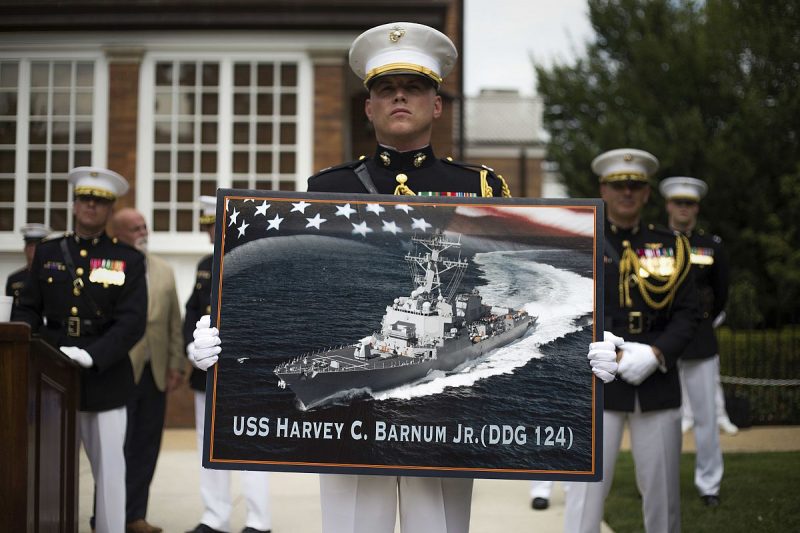In a ceremony led by Navy Secretary Ray Mabus, a new Navy destroyer was named after Col. Harvey C. Barnum Jr., a Marine Medal of Honor recipient. This ship, officially called DDG 124, with others of its class, will complete global missions such as guarding aircraft carriers. They are well equipped for the job, armed with guns, missiles, and torpedoes.
“Destroyers are kind of like the person we’re honoring here today,” Mabus said during the ceremony. “They’re incredibly versatile, and they can do a lot of things at once.”
The audience in Thursday’s ceremony consisted of past Marine commandants and of Barnum’s friends from his time in service. In his speech, Mabus emphasized his belief that Barnum’s career in particular demonstrates admirable resilience and dedication – the same characteristics, he said, that can still be found in today’s Navy and Marine Corps.
Colonel Barnum has a remarkable service history. He was awarded the nation’s highest award for valor. Once part of the 2nd Battalion, 9th Marines, he was deployed to Vietnam during that war. He had the rank of 1st Lieutenant at that time. On December 18th, 1965, his company was ambushed in a surprise attack just outside of the village of Ky Phy, Quang Tin province. Outnumbered, they suffered severe losses, including their commander and radio operator.
Keeping his training in mind, Barnum took control of the situation. After a quick and dangerous reconnaissance, Barnum reorganized his units and sought out enemy targets. He gave encouragement when needed, and the counterattack he launched was successful, despite the heavy fire raining down on him and his men.
His award citation states, “His sound and swift decisions and his obvious calm served to stabilize the badly decimated units and his gallant example as he stood exposed repeatedly to point out targets served as an inspiration to all.”
After the war, he went on to serve as the Deputy Assistant Secretary of the Navy for Reserve Affairs, eventually retiring in 1989. Because the Vietnam War was so unpopular at that time, the hero did not receive the award in a traditional White House ceremony.
In an interview with Marine Corps Times, Barnum expressed the hope that the ship will allow him to connect with the “newest greatest generation” of Marines and Sailors. Moreover, he said that he hoped to be able to visit the ship during its construction and to be able to meet the ship’s crew when the time comes. His aim is to pass on any advice he can give, as well as any values that influenced or helped him as he served as a Marine.
“The three words that drive all Marines: honor, courage, and commitment,” Barnum said. “I want to let them know they are the linchpin to our success – that ship is just a floating piece of metal until they get aboard it.”
The destroyer Harvey C. Barnum Jr. is the sixth Navy ship that Mabus has chosen to christen after a Medal of Honor recipient. Measuring 509 feet long and capable of exceeding 30 knots, the ship will be constructed at Maine’s Bath Iron Works and will enter the fleet in the year 2024.
With the specs aside, these ships represent more than military power. They are a way for the heroes of past conflicts to be honored again. As Mabus puts it, “It’s important when we can honor people who are still with us and thank them for what they did, and thank them in a tangible way.”
